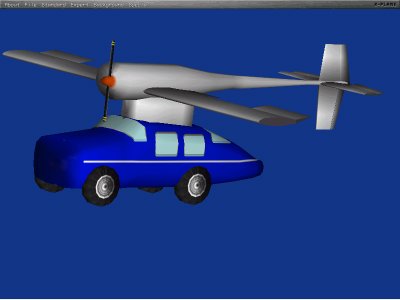

 |
 |
The following was drawn from an article at Retrofuture.com
On paper, the ConvAIRCAR was truly the stuff of commuters' fantasies. It had "all the advantages of a Cadillac" according to its manufacturer. So what happened? The same thing that happens to all flying cars--the dream crashed and burned before it could take off...this time literally.
The ConvAIRCAR was not the first flying car to make it to the drawing board. That honor goes to the Curtiss Autoplane of 1917. But public interest in a car-plane hybrid didn't take hold until after World War II. Airplane manufacturers, after the war, were shifting away from military aircraft to consumer production lines.
The Consolidated Vultee Aircraft Company of San Diego, California was one of those companies looking for a new outlet to sell their aircraft. Sensing the time was right for a flying car, they poured hundreds of thousands of dollars into developing a prototype built by aerodynamic engineer Theodore P. Hall. Also lending a hand was Henry Dreyfuss, one of the outstanding industrial designers of the 20th century. Dreyfuss designed telephones for Bell, tractors for John Deere, thermostats for Honeywell, and cameras for Polaroid. But a flying car? What motivated the famously no-nonsense Dreyfuss--a devotee of Louis Sullivan's dictum that "form follows function"--to lend his talents to such a far-fetched endeavor? The cynic would say money; but, in truth, a flying car didn't seem that far-fetched at the time.
"The market for this flying automobile will be far greater than a conventional light plane," Consolidated Vultee promised, "because the purchasers can obtain daily use from the car to get more out of his investment." The estimated cost: $1,500. Flight attachments were an additional cost. These attachments were integral to the ConvAIRCAR's design. After driving to the airport, an owner had to connect a flight unit (which included a propeller) to take off. At the next airport they simply removed the detachable wings and drove away in what was an otherwise ordinary car. Well, not exactly ordinary. Thanks to a "plastic-impregnated" fiberglass body that weighed only 725 pounds, the ConvAIRCAR achieved an astounding 45 miles per gallon. And it looked great--the aerodynamic envelope of "the only automobile that flies" was a remarkable achievement, truly years ahead of its time.
On November 17, 1947, the New York Times announced the news: a prototype of the ConvAIRCAR had circled San Diego for one hour and 18 minutes. These trials confirmed the best hopes of Consolidate Vultee. But success was short-lived. A few days after the test flight, a pilot crash-landed the ConvAIRCAR in the desert (it was later discovered a gas gauge had accidentally been shut off) and the only prototype in existence was demolished beyond repair. Eventually another model of the ConvAIRCAR was built but the damage was done. The high cost of production and the limited market potential--not to mention the negative publicity--spelled doom (sadly no examples of the ConvAIRCAR survive; the second prototype perished in a fire at the San Diego Air & Space Museum).
The failure of the ConvAIRCAR was not unique. Dozens of inventors and aerodynamic engineers have tried to create similar vehicles in the last fifty years--none has successfully marketed a flying car. According to a 1989 article in Smithsonian, over 30 patents for flying cars have been filed this century in the United States alone; usually boasting fanciful names like Aerocar, Autoplane, Airphibian, and Skycar.
The Convair ConvAIRCAR is currently at version 1.0.
Download the Convair ConvAIRCAR version 1.0 (X-Plane version 5.62)

| Email James Z Temple | Return to Home Page |